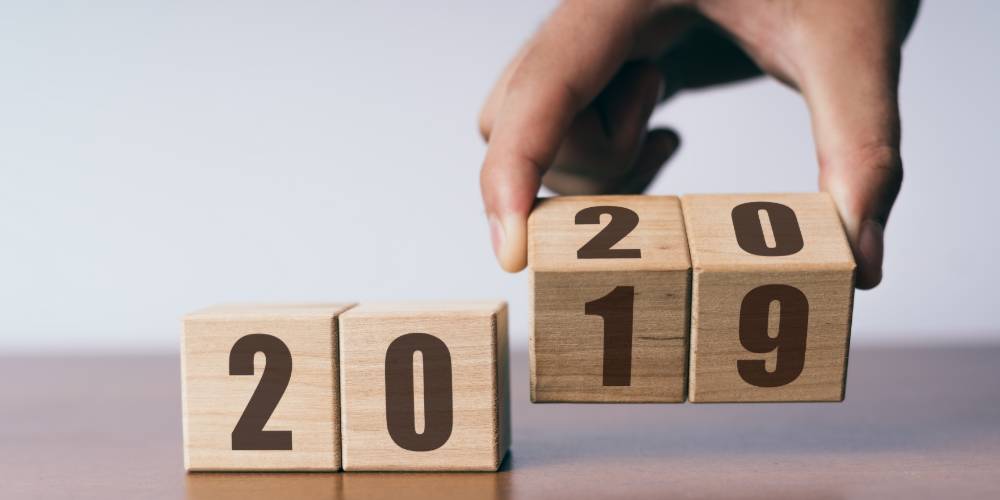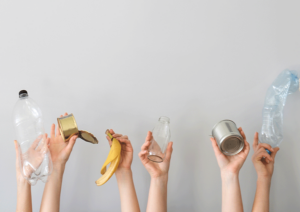Introduction
If one theme loomed large in the solid waste industry in 2019, it certainly was contamination of recyclable materials. But if we take a step back to view how the overall landscape has changed for program operators and educators since China’s National Sword program took effect in 2017, effectively forcing US recycling programs to clean up their streams, we can see that the entire industry is undergoing an overhaul that, it may be optimistically argued, has the power to transform our waste systems for the better in the long run.
Many environmental educators have seized this moment, when recycling has been the top story in mainstream news – from the New York Times to The Atlantic to Forbes – to grab the attention of would-be and should-be recyclers, and to better inform those who already recycle how to recycle more and better.
The changing market forced recycling programs to step operations up a notch, and even smaller municipal programs have invested in high-end sorting equipment and digital solutions for education. Moreover, while a number of programs have shuttered or sent recyclables to debated waste-to-energy facilities due to the inability to keep up with increased restrictions, new programs have sprung up, some with the help of nationwide and grassroots efforts and support. Furthermore, in the second half of 2019, the US government passed legislation tasking the EPA with creating standardized recycling labels.
Despite renewed global focus on recycling, the likes of which has not been seen since the 1990s, other waste trends continue to spell environmental trouble for the future: The pace of waste generation, especially in industrialized countries, is still growing; food waste remains a global problem, carrying organics to the forefront of many waste discussions; and plastics continue to threaten our oceans and the wildlife living there.
Several pressing issues demanded our collective attention in 2019, and the work has been arduous. Yet program operators and educators have stepped up to the challenge with renewed focus, creativity and energy.
“Is This the End of Recycling?”
This was the big, hyperbolic question as phrased by The Atlantic in a March headline. The answer, of course, is decidedly no.
And yet some programs did end. According to Waste Dive, “nearly 60 curbside programs have been cancelled, with even more drop-off site closures and material limitations.”
Perhaps a better question would have been, “Is this the end of recycling as we have known it since the 1990s?” And the answer to that question, in some ways, is yes: “While local governments are struggling to adapt to this new reality, and portrayals of national chaos are an exaggeration, the effects have been noticeable,” Waste Dive reported.
Big changes were afoot in 2019, and it’s likely that the solid waste industry will continue to be impacted by global market factors requiring the industry to respond with flexibility and ingenuity.
Contamination: The Elephant in the Room
About 25 percent of what residents place in their blue bins is actually trash, according to the National Waste & Recycling Association.
In 2019 contamination continued to loom as the biggest issue in recycling, just as it was in 2018 following the passage of China’s National Sword program.
As the New York Times reported in March, “Prompting this nationwide reckoning is China, which until January 2018 had been a big buyer of recyclable material collected in the United States. That stopped when Chinese officials determined that too much trash was mixed in with recyclable materials like cardboard and certain plastics.”
As solid waste professionals focused on contamination, they sought root causes, as well.
Some contamination is due to the phenomenon known as “wish-cycling”- when good intentions get the best of enthusiastic recyclers, inspiring them to toss non-recyclable items into the bin. Another reason for contamination is lack of effective education: According to a recent report by The Recycling Partnership, most recycling programs provide conflicting information about “what goes in,” and many get this information to residents in formats that aren’t ideal.
To stem the tides of inspired but incorrect “recycling” and better inform people about what materials belong where, recycling education received a reactive but much needed shot in the arm. Not since the 1990s has recycling education seen the spotlight in national publications with any regularity, but in 2019 recycling became a mainstream topic of interest—and wise recycling educators seized the moment to build more effective strategies for communicating with residents and keeping them engaged, often through digital tools.
Recycling Program Changes & Hard Questions
With fewer buyers for materials, recycling companies struggled to recoup their lost profits by charging cities more – in some cases four times what they charged in 2018, as reported by the New York Times.
Overwhelming costs did indeed cause some recycling programs to end, while others responded by making changes to how recyclables are processed.
Rather than pay steep prices for contamination, some cities and municipalities have opted to incinerate at least some recyclables, as in Philadelphia, where recycling has long been valued by the community. Using program data, leaders identified which routes experienced the most contamination, then strategically sent those materials for incineration, continuing regular recycling across the rest of the city. It wasn’t a solution everyone agreed with, but the program is still running.
It bears noting that cities without access to data that identifies problematic routes were not able to make such nuanced decisions, and some of them began sending all recyclables for incineration.
In many ways the challenges of 2018 and 2019 brought difficult but not exactly new questions about solid waste management to the fore. Some even argued that facing tough issues head-on could result in positive changes for the industry.
“Recycling has been dysfunctional for a long time, but not many people really noticed when China was our dumping ground,” Mitch Hedlund told the New York Times. Hedlund is the executive director of Recycle Across America, a nonprofit organization that pushes for more standardized labels on recycling bins to help people better sort material.
Looking to the Future: Investments in Infrastructure
While much media attention in 2019 tended to focus on the ways that the China Ban handicapped recycling business as usual, serious efforts to transform recycling for good were ramping up at the same time.
One exceptionally bright light for recycling in 2019 came from The Recycling Partnership, which rolled out new grant programs to jumpstart recycling across the US and provide special help to coastal areas impacted most by ocean-borne plastics. The organization, now five years old, also brought together public and private interests by forging partnerships with some of the biggest names in the beverage industry, including the arch rivals Pepsi and Coke, all for the sake of the growing the circular economy.
Other investments – inside materials recovery facilities themselves – are improving recycling outputs by removing contaminants through engineering technology.
Equipment such as screens that use gravity to sort materials; optical sorters that determine the thickness of plastic by shining light on them and then directing them to the correct bin with puffs of air; magnets; and eddy current systems that react with aluminum to send it flying into a separate area of the sorting facility are helping many facilities sort better.
According to at least one report, better sorting at US facilities may even help US-based markets for paper and plastics gain a foothold.
“Solutions are coming,” reported Waste Dive in late 2019. “About a dozen curbside programs have been revived in various forms. As of summer 2019, when Waste Dive contacted each state environmental agency once again, many efforts to improve education and infrastructure were underway. Still, the U.S. recycling infrastructure is far from done evolving and further changes should be expected for possibly years to come.”
Recycling Standardization
In the US, legislators have keyed on the difficulties created by disparate recycling communications among programs and communities. In response, they crafted a mandate to standardize recycling labels nationwide.
By September 2019, the FY 2020 Interior, Environment Appropriations Bill had cleared the Senate Committee on Appropriations with the mandate included.
The new bill directs the EPA “to develop, in collaboration with for-profit, non-profit, state and local governments, and other stakeholders, a national recycling strategy to strengthen and sustain the current system with recommendations for voluntary action to be reported to the Committees on Appropriations within 270 days of enactment,” according to a summary by Forbes.
Plastics and Our Oceans
Without concerted effort, by 2050, the world’s oceans will contain more plastics than fish.
That’s a startling statistic from Ocean Conservancy, which in 2017 released a groundbreaking report on the topic: Stemming the Tide: Land-Based Strategies for a Plastic-Free Ocean.
As the world’s population continues to grow, demand for plastics will grow along side it. Plastics have become the workhorse of the modern economy, the report notes. They won’t be going away anytime soon. To help save our oceans, however, we need better strategies at every point in the life-cycle of plastic, from product design to recovery to treatment.
Currently about 80 percent of global plastic waste is worth too little to “incentivize extraction,” the report says, and about a third can’t be sorted without significant investment at the MRF level in optical sorting equipment. It’s these low-value plastics that are most likely to end up in the water, and a majority of them are leaked from China, Indonesia, the Philippines, Thailand, and Vietnam – where lots of low-value plastics from North America have historically ended up.
Although the problem with plastic is global in nature, acting locally is still the best way for individuals to make a difference. And while recycling is not the silver bullet for the plastics problem, those who have studied the issue say it will continue to play a core role in addressing the issue of plastics in our oceans.
With the right combination of short- and long-term actions, the report concludes that we could “essentially eliminate plastic-waste leakage from the (top plastic leaking) countries by 2035.”
Tech Disruption and Data, Data, Data
From all sources, it is clear that technological innovation, including the collection and wise use of solid waste data, will play an important role in keeping our planet clean and green.
In fact, in its 300-plus page “What a Waste 2.0,” World Bank cites data as the first solution to the pressing issues of increasing global waste at the local level: “Waste management data are critical to creating policy and planning for the local context. Understanding how much waste is generated – especially with rapid urbanization and population growth – as well as the types of waste being generated, allows local governments to select appropriate management methods and plan for future demand. This knowledge allows governments to design systems with a suitable number of vehicles, establish efficient routes, set targets for diversion of waste, track progress, and adapt as waste generation patterns change. With accurate data, governments can realistically allocate budget and land, assess relevant technologies, and consider strategic partners, such as the private sector or nongovernmental organizations, for service provision.”
Solid waste stakeholders already know the value of data; the challenge for municipalities and haulers alike over the next several years will be selecting, implementing and maintaining digital waste and recycling tools and operations that collect and provide the data they need to provide sustainable programs for today and the future.
Organics: ‘Green’ Waste, Food Waste
In 2019 organics waste and food loss continued to pose a global challenge to food security and safety, the economy and the environment, according to the World Bank Report.
Globally organics comprise about half of waste, according to the World Bank. This percentage hovers around a third in affluent countries because it’s offset by much larger amounts of packaging waste.
In North America, uneaten food represents about a third of our trash. Moreover, in 2017, the most recent year for which EPA data are available, only about six percent of US food waste was composted.
The good news is, more communities are responding to the issue by creating programs to address it. According to Waste 360, recycling and yard waste can help solid waste programs divert up to 35 percent of materials from the landfill. To reach a 50-percent diversion rate, however, diverting food waste becomes essential.
As communities continue to identify operational and programmatic needs, cost-effective and efficient solutions for ongoing education, such as digital communications for solid waste, will only grow in importance.
More Garbage Overall
As economies grow, so does solid waste: And the economy is indeed expanding.
The global economy was projected to grow at 3.5 percent in 2019 and 3.6 percent in 2020, according to The International Monetary Fund. At this rate, the global solid waste load is expected to increase from 2 billion tons (2016) to 3.4 billion tons by 2050, reports the World Bank.
Sustainable waste management programs in North America will continue to play an important role, not only for waste handling but also education.
As affluent societies continue to generate more trash over time, effective education around program use and the traditional “Three Rs” —in order of importance: reduce, reuse, recycle—becomes ever more crucial. Likewise, the ability to engage residents and customers with this content to educate and inform will be paramount.
Conclusion
The repercussions of the solid waste decisions we make in North American continue to create ripples far beyond our own cities and counties.
Poorly managed waste, particularly plastics consumed by affluent nations, harm our oceans and create other problems for the environment and human health that affect less affluent regions in a disproportionate way, says World Bank.
In 2020 and certainly beyond, North American solid waste professionals will respond to urgent and long-term issues created by global and local forces. As they do so, they will shape the future of solid waste, influencing how residents consume and discard materials for generations to come.
The challenges in the solid waste industry have always required innovation and creativity. But in our global community today, the amount of human care these challenges demand—the care for other people, the care for our planet and its plants and animals—represents perhaps the greatest opportunity of all.





